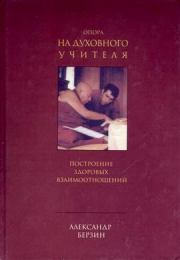Александр Берзин - Опора на духовного учителя: построение здоровых взаимоотношений
 | Название: | Опора на духовного учителя: построение здоровых взаимоотношений |
Автор: | Александр Берзин | |
Жанр: | Буддизм | |
Изадано в серии: | неизвестно | |
Издательство: | Нартанг | |
Год издания: | 2002 | |
ISBN: | неизвестно | |
Отзывы: | Комментировать | |
Рейтинг: | ||
Поделись книгой с друзьями! Помощь сайту: донат на оплату сервера | ||
Краткое содержание книги "Опора на духовного учителя: построение здоровых взаимоотношений"
Правильное отношение к учителю - краеугольный камень духовной практики. Однако у нас на Западе само понятие "учитель" за последнее столетие было искажено, крайне мистифицировано и нуждается в очищении. Именно этому и посвящена данная книга А. Берзина.
Помимо просветления основ правильных отношений между учеником и учителем, автор рассматривает и самые сложные аспекты этих отношений, в частности принцип отношения к учителю как к Будде. Это чрезвычайно важная тема, особенно для тех, кто получал тантрийские посвящения и пытается практиковать тантру.
Оригинал книги: www.berzinarchives.com/web/x/nav/group.html_785322033.html
Читаем онлайн "Опора на духовного учителя: построение здоровых взаимоотношений". [Страница - 140]
Rigdzin Chokyi-dragpa (Rig-'dzin Chos-kyi grags-pa) (b. 1595) rGyud-sde'i snying-po lnga-ldan-gyi nyams-len (The Heart of the Tantras: The Fivefold Practice [of Mahamudra]).
Sakya Pandita (Sa-pan Kun-dga' rgyal-mtshan) (1182-1251). sDom-gsum rab-dbye (The Divisions of the Three Sets of Vows).
_______. Lam zab-mo bla-ma'i rnal-'byor (The Profound Path of Guru-Yoga).
_______. Legs-bshad rin-po-che'i gter (A Precious Treasury of Elegant Sayings).
Sangwayjin (gSang-ba'i byin). sKyes-bu gsum-gyi lam-rim rgyas-pa khrid-su sbyar-ba (An Extensive Presentation of the Graded Stages of the Path for the Three Scopes of Spiritual Seekers, Arranged in a Discourse).
Shantideva (Zhi-ba lha) (8th century). Bodhisattvacaryavatara (Byang-chub sems-pa'i spyod-pa-la 'jug-pa; Engaging in Bodhisattva Behavior).
Sherab-senggey (rGyud Shes-rab seng-ge) (1383-1445). sGron-gsal rgya-cher bshad-pa le'u dang-po rgya-cher bshad-pa (An Extensive Explanation of [Chandrakirti's] Illuminating Lamp: An Extensive Explanation of Chapter One).
Sonam-tsemo (bSod-nams rtse-mo) (1142-1182). Chos-la 'jug-pa'i sgo (The Gateway for Entering the Dharma).
Taranata (Ta-ra na-tha) (1575-1634). rGyal-ba'i bstan-pa-la 'jug-pa'i rim-pa skyes-bu gsum-gyi man-ngag-gi khrid-yig bdud-rtsi'i nying-khu (The Stages for Engaging in the Triumphant One's Teachings: Discourse Notes on the Guideline Instructions Concerning the Three Scopes of Spiritual Seekers: The Essence of Nectar).
Terdag Lingpa (gTer-bdag gLing-pa sMin-gling gter-chen 'Gyur-med rdo-rje) (1646-1714). Rin-chen them-skas (A Precious Ladder; The Jewel Ladder).
Tsangpa-gyaray (Tsang-pa rgya-ras Ye-shes rdo-rje) (1161-1211). Bla-ma'i ngo-sprod rmus-long mig-'byed (Introduction by the Guru to Open Blind Eyes).
_______. Bla-ma'i sgrub-thabs thugs-rje nyi-rgyas (Actualizing through One's Guru: The Expansive Sun of Compassion).
Tsarchen (Tshar-chen Blo-gsal rgya-mtsho) (1502-1566). bShes-gnyen dam-pa bsten-par byed-pa'i thabs shlo-ka lnga-bcu-pa'i 'grel-ba (Methods for Building a Relationship with a Proper Spiritual Mentor: A Commentary on [Ashvaghosha's] Fifty Stanzas [on the Guru]).
Tsongkhapa (Tsong-kha-pa Blo-bzang grags-pa) (1357-1419). Bla-ma lnga-bcu-pa'i rnam-bshad slob-ma'i re-ba kun-skong (An Explanation of [Ashvaghosha's] Fifty Stanzas on the Guru: The Complete Fulfillment of Disciples' Hopes; The Fulfillment of All Hopes).
_______. dBu-ma-la 'jug-pa'i rgya-cher bshad-pa dgongs-pa rab-gsal (Totally Clarifying the Intention: An Extensive Explanation of [Chandrakirti's] Supplement to [Nagarjuna's "Root Stanzas on] the Middle Way").
_______. Drang-nges legs-bshad snying-po (The Essence of Excellent Explanation of Interpretable and Definitive Phenomena; The Essence of True Eloquence).
_______. Lam-gyi rim-pa mdo-tsam-du bstan-pa (A Brief Indication of the Graded Stages of the Path).
_______. Lam-rim bsdus-don (The Abbreviated Points of the Graded Stages of the Path).
_______. Lam-rim chen-mo (A Grand Presentation of the Graded Stages of the Path).
_______. Lam-rim chung-ngu (A Short Presentation of the Graded Stages of the Path; The Middle-Length Presentation of the Graded Stages of the Path).
_______. Lam-gtso rnam-gsum (The Three Principal Aspects of the Path).
_______. Legs-bshad gser-phreng (A Golden Garland of Excellent Explanation).
_______. gSang-sngags-kyi rim-pa chen-mo (A Grand Presentation of the Graded Stages of the Secret Mantra Path).
Udanavarga (Ched-du brjod-pa'i tshoms; Special Verses Grouped by Topic; The Tibetan Dhammapada).
Vajramala (rDo-rje phreng-ba; A Vajra Garland).
Vanaratna (Nags-kyi rin-chen) (b. 1384) and Go Lotsawa ('Gos Lo-tsa-ba gZhon-nu dpal) (1392-1481) (transl.) Gurvaradhanapanjika (Bla-ma'i bsnyen-bkur-gyi dka'-'grel; A Commentary on Difficult Points [in Ashvaghosha's Fifty Stanzas on the Guru] concerning Helping and Showing Respect to a Guru).
Vasubandhu (Vasubandhu, dByig-gnyen) (4th or 5th century). Abhidharmakosha (Chos mngon-pa'i mdzod; A Treasure-House of Special Topics of Knowledge).
________. Abhidharmakosha-bhashya (Chos-mngon-pa'i mdzod-kyi rang-'grel; An Auto-Commentary on A Treasure-House of Special Topics of Knowledge).
Wonpo Sherab-jungnay (dBon-po Shes-rab 'byung-gnas) (1187-1241). Dam-chos dgong-pa gcig-pa'i 'grel-chen (A Grand Commentary to [Drigungpa's] Single Intention of the Sacred Dharma).
Yeshey-gyeltsen (Yongs-'dzin dKa'-chen Ye-shes rgyal-mtshan) (1713-1793). Bla-ma mchod-pa'i khrid-yig gsang-ba'i gnad rnam-par phye-ba snyan-rgyud man-ngag-gi gter-mdzod (Discourse Notes on [the First Panchen Lama's] Ceremony to Honor the Gurus: A Treasure-House of Guideline Instructions from the Oral Tradition Revealing the Hidden Important Points).
_______. Sems-dang sems-byung-gi gsal-bar ston-pa blo-gsal mgul-rgyan zhes sdom-'grel (An [Auto-]Commentary on Mneumonic Verses, Indicating Clearly the Primary Minds and Mental Factors: A Necklace for a Clear Mind; The Necklace of Clear Understanding).
Переводы и другая литература
Aryadeva and Gyel-tsap. Yogic Deeds of Bodhisattvas: Gyel-tsap on Aryadeva's "Four Hundred," with commentary by Geshe Sonam Rinchen. Trans. and ed. Ruth Sonam. Ithaca: Snow Lion, 1994.Aryasura. The Marvelous Companion: Life Stories of the Buddha. Berkeley: Dharma Publishing, 1983.
Atisha. A Lamp for the Path and Commentary. Trans. Richard Sherburne, S. J. London: George Allen & Unwin, 1983.
Berzin, Alexander. Developing Balanced Sensitivity. Ithaca: Snow Lion, 1998.
_______. Taking the Kalachakra Initiation. Ithaca: Snow Lion, 1997.
Berzin, Alexander and Jampa Gendun et al., trans. The Guru Puja. Dharamsala: Library of Tibetan Works and Archives, 1979.
Berzin, Alexander and Sharpa Tulku, trans. "A Letter of Practical Advice on Sutra and Tantra: A Brief Indication of the Graded Stages of the Path, Lam-gyi rim-pa mdo-tzam-du bstan-pa." In Thurman, Robert A. F., ed. Life and Teachings of Tsong Khapa. Dharamsala: Library of Tibetan Works and Archives, 1982, 67-89.
_______. "Lines of Experience: The Abbreviated Points of the Graded Path, Lam-rim bsdus-don." In Ibid., 59-66.
Boszormenyi-Nagy, Ivan and G. H. Spark. Invisible Loyalties. New York: Brunner/Mazel, 1984.
Capra, Fritjof. The Web of Life: A New Scientific Understanding of Living Systems. New York: Anchor Books, 1996.
The Dalai Lama, H. H., Tenzin Gyatso. Path to Bliss: A Practical Guide to Stages of Meditation. Trans. Geshe Thubten Jinpa. Ithaca: Snow Lion, 1991.
_______. The Path to Enlightenment. Cf. Gyatso, Sonam, The Third Dalai Lama. Essence of Refined Gold.
_______. The Union of Bliss & Emptiness: A Commentary on the Lama Choepa Guru Yoga Practice. Trans. Thupten Jinpa, trans. Ithaca: Snow Lion, 1988.
_______. The World of Tibetan Buddhism: An Overview of Its Philosophy and Practice. Trans. Geshe Thupten Jinpa. Boston: Wisdom, 1995.
The Dalai Lama, H. H. and Alexander Berzin. The Gelug/Kagyü Tradition of Mahamudra. Trans. and ed. Alexander Berzin. Ithaca: Snow Lion, 1997.
Dhargyey, Geshe Ngawang. An Anthology of Well-Spoken Advice, vol. 1. Trans. and ed. Alexander Berzin, with Sharpa Tulku. Dharamsala: Library of Tibetan Works & Archives, 1984.
Gampopa, Je. The Jewel Ornament of Liberation. Trans. Khenpo Konchog Gyaltshen Rinpoche. Ithaca: Snow Lion, 1998.
Gtsan-smyon He-ru-ka. The Life of Milarepa. Trans. Lobsang P. Lhalungpa. New York: Dutton, 1977.
Guenther, Herbert V., trans. The Life and Teachings of Naropa. Boston: Shambhala, 1986.
Guenther, Herbert V. and Leslie S. Kawamura. Mind in Buddhist Psychology: A --">Книги схожие с «Опора на духовного учителя: построение здоровых взаимоотношений» по жанру, серии, автору или названию:
Другие книги автора «Александр Берзин»:
 |
| Александр Берзин - Предварительные практики для медитации и изучения: семичастная практика Жанр: Буддизм |









